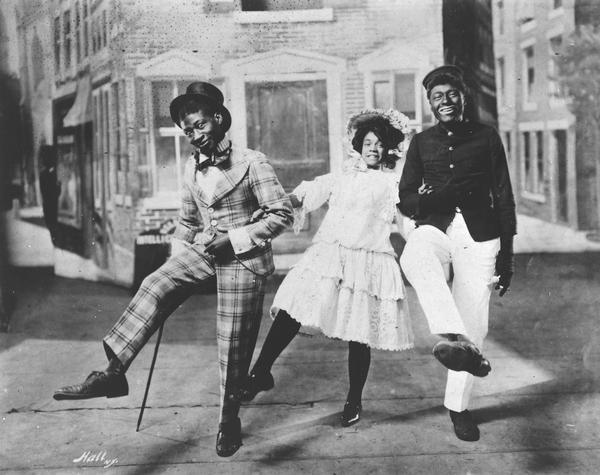|
Buzzard Lope
The Buzzard Lope is a popular southern States dance dating from the 1890s, included in Minstrel Show repertoire, alongside the cakewalk and juba dance. Ostensibly, it is a representation of "a turkey buzzard getting ready to eat a dead Mule (some report a Cow)", performed with a comic sensibility known as hokum Hokum is a particular song type of American blues music—a humorous song which uses extended analogies or euphemistic terms to make sexual innuendos. This trope goes back to early blues recordings and is used from time to time in modern Ameri .... Reference is made to the dance in the penultimate line of the American blues/folk song "Johnny Brown": Little Johnny Brown, spread your comfort down (2x) Fold one corner, Johnny Brown Fold another corner, Johnny Brown (3x) Take it to your lover, Johnny Brown (2x) Show her your motion, Johnny Brown (2x) Lope like a buzzard, Johnny Brown (2x) Give it to your lover, Johnny Brown (2x) References {{reflist Dances of the Uni ... [...More Info...] [...Related Items...] OR: [Wikipedia] [Google] [Baidu] |
Minstrel Show
The minstrel show, also called minstrelsy, was an American form of racist theatrical entertainment developed in the early 19th century. Each show consisted of comic skits, variety acts, dancing, and music performances that depicted people specifically of African descent. The shows were performed by mostly white people wearing blackface make-up for the purpose of playing the role of black people. There were also some African-American performers and black-only minstrel groups that formed and toured. Minstrel shows caricatured black people as dim-witted, lazy, buffoonish, superstitious, and happy-go-lucky.The Coon Character , Jim Crow Museum of Racist Memorabilia, Ferris State University. Retrieved 29 January 2016.John Kenrick [...More Info...] [...Related Items...] OR: [Wikipedia] [Google] [Baidu] |
Cakewalk
The cakewalk was a dance developed from the "prize walks" (dance contests with a cake awarded as the prize) held in the mid-19th century, generally at get-togethers on Black Slavery in the United States, slave plantations before and after End of slavery in the United States of America, emancipation in the Southern United States. Alternative names for the original form of the dance were "chalkline-walk", and the "walk-around". It was originally a processional partner dance danced with comical formality, and may have developed as a subtle mockery of the mannered dances of white slaveholders. Following an exhibition of the cakewalk at the 1876 Centennial Exposition in Philadelphia, the cakewalk was adopted by performers in minstrel shows, where it was danced exclusively by men until the 1890s. At that point, Broadway shows featuring women began to include cakewalks, and grotesque dances became very popular across the country.. The fluid and graceful steps of the dance may have g ... [...More Info...] [...Related Items...] OR: [Wikipedia] [Google] [Baidu] |
Juba Dance
The Juba dance or hambone, originally known as Pattin' Juba (Giouba, Haiti: Djouba), is an African-American style of dance that involves stomping as well as slapping and patting the arms, legs, chest, and cheeks (clapping). "Pattin' Juba" would be used to keep time for other dances during a walkaround. A Juba dance performance could include: *counter-clockwise turning, often with one leg raised *stomping and slapping *steps such as "the Jubal Jew", " Yaller Cat", "Pigeon Wing" and "Blow That Candle Out". The dance traditionally ends with a step called " the Long Dog Scratch". Modern variations on the dance include Bo Diddley's "Bo Diddley Beat" and the step-shows of African American Greek organizations. History of the dance The Juba dance was originally brought by Kongo slaves to Charleston, South Carolina. It became an African-American plantation dance that was performed by slaves during their gatherings when no rhythm instruments were allowed due to fear of secret codes h ... [...More Info...] [...Related Items...] OR: [Wikipedia] [Google] [Baidu] |
Hokum
Hokum is a particular song type of American blues music—a humorous song which uses extended analogies or euphemistic terms to make sexual innuendos. This trope goes back to early blues recordings and is used from time to time in modern American blues and blues rock. An example of hokum lyrics is this sample from "Meat Balls", by Lil Johnson, recorded about 1937: Technique In a general sense, hokum was a style of comedic farce, spoken, sung and spoofed, while masked in both risqué innuendo and "tomfoolery". It is one of the many legacies and techniques of 19th century blackface minstrelsy. Like so many other elements of the minstrel show, stereotypes of racial, ethnic and sexual fools were the stock in trade of hokum. Hokum was stagecraft, gags and routines for embracing farce. It was so broad that there was no mistaking its ludicrousness. Hokum also encompassed dances like the cakewalk and the buzzard lope in skits that unfolded through spoken narrative and song. W. C. H ... [...More Info...] [...Related Items...] OR: [Wikipedia] [Google] [Baidu] |


.jpg)